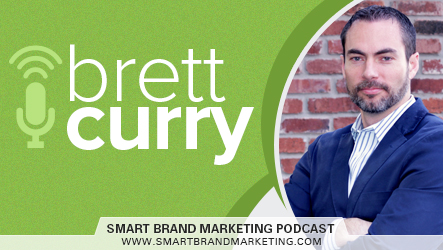Podcast: Play in new window | Download | Embed
Today’s Guest

Brett Curry is the founder of OMG Commerce.
This is the 63rd session of Smart Brand Marketing.
Brett used to work heavily with local seo but switched to eCommerce.
We accomplished all that so press play.
TOPICS DISCUSSED
- What has changed in local marketing
- Easy wins with schema, markup and reviews
- Big wins in E-commerce
- Do’s and Don’ts with Google Shopping
- Remarketing lists
- Youtube placements and perfect ad structure
- Abandoned carts and how to get those customers back
- Why you need to start fixing funnels at the checkout
Enjoy!
How to Stop Losing Customers in Your E-Commerce Store?
E-commerce, as with any business in the real world, faces some problems. One of the biggest problems it has is the prospect of losing or, at worse, hemorrhaging customers on a regular basis.
Customer retention has always been a big problem with online businesses as the potential market is bigger and the structure of the business is far less defined than that of conventional ones.
However, is there a way to improve customer retention in your business? Are there ways to stop the business from losing more?
The answer for both is in the positive and, to do these, there are a few things we have to lay out first.
The Market: What Changed?
The first thing that you have to understand is that the market is never this huge, unchanging entity. It can break down, reform, segregate itself, and change the playing field depending on changes in larger industries. As far as e-commerce is concerned, there are changes that you have to take not of such as:
- 1. Push for Data Accuracy

In recent years, Google’s search engine has experienced a major algorithm, update which have changed the way the search engine treats queries (Source: https://unamo.com/blog/seo/google-hummingbird-update). From what was a fact-based approached, the algorithms now treat questions as localized issues.For example, if one types in “toy stores” in Google’s search engine, Google thinks that what you are looking for is not a definition of a toy store but the nearest toy stores in your area. As such the query “toy store” acts less like “what is a toy store?” and more like “what are the best toy stores in (insert area here)?”This only means that your business should get its most basic data right from the address, your phone numbers, reviews, and the type of services it offers. Properly entering this in the information and cleaning in in your website or even your social media accounts and even the proper tags will go a long way in helping Google identify if your webpages are relevant to the question being posed by the user.
- 2. Reviews/Testimonials/Referrals MatterRecently, Google has been thinking less of what you think your business is and what other people have to say about you. Reviews play a major role in search engine queries these days as Google will not only rank your websites according to how relevant they are with the search query but also as to your rankings compared to other similar businesses in the local area.Since there is little that you can do to control the impression people have with your business and products, the best that you can hope for is that people will actually like what you offer and then rate you something good. If you have a generous amounts of good ratings and feedback, you then have to push for these to appear in your different websites.
There are still other incremental changes being implemented in the search engines but, right now, the two are the ones that you should be concerned the most with your e-commerce efforts. How you adapt to these changes will actually determine how much you can retain of your customer base as soon as they are implemented.
How to Use Google Shopping?
Google Shopping is perhaps an online businessman’s best friend as it is essentially a combination between a product listing tool and an advertising platform. How it works is quite simple. First, you enter in the type or name of a product.
Once Google understands that this is a product query, it will immediately come up with a list of products along with their important details including size, weight, availability, average pricing, and where they can be bought at.
Using Google Ads in your marketing campaign can make for a rather effective strategy provided, of course, that you know what you are doing. To make this possible, there are a few tips that you should keep in mind.
- 1. Set Your Feed Correctly

A Google product ad can be broken into 3 main sections: The Title, The Price, and The Picture. When setting up your ad, you must make sure that all three sections are true and are relevant to one another. Basically, the picture should match the product, the price match the title, and the title should accurately describe the title. Also, the keywords you use for the product should be descriptive but not too long. This is so that Google does not get confused as to where your product should be listed in every search query. - 2. Submit The Inventory

Every entry you will make for your Google Shopping ad will eventually have to be submitted to the Merchant Center. If you want to increase the chances of your products appearing in the topmost results, you should have prepared an entire inventory’s worth of entries before submitting them.However, here’s a bit of warning. Google Merchant is actually stricter in products that deal with a sensitive nature or are designed to attend to a very specific and sensitive need. Pharmaceuticals and healthcare products, for instance, have stricter screening processes which means that you have to make sure that the information you give for them (if you are selling them, of course) is as accurate as possible.Don’t worry about account suspensions, though, as Google has done away with that. Instead, every entry with misleading or inadequate content will be marked for disapproval. Simply put, Google rejects your entry from any product listing ad but gives you the chance to rectify it ASAP.
- 3. Let Your Product do the Talking

The best way to use Google Shopping is to actually do away with the entire search ad, SEO-like mentality. Yes, a keyword-heavy approach can make you look good in search engines but they are a pain to maintain especially when algorithm updates are being implemented.Instead, you should focus on the date you enter and make sure it is as accurate as possible. Shoppers online are actually looking at the date of your entries and, if they feel that it is accurate and meets their needs, they won’t need further convincing to purchase it.Think of it this way: directing traffic to your pages with your SEO techniques is a good strategy but the actual quality of the products and services you offer will determine whether a sale occurs or not.
Remarketing: How Do I do This?
The word remarketing is often thrown about in many advertising campaigns so much that it can be a daunting concept for starting business owners. However, remarketing is actually quite a simple concept. Here’s how it works:
So, for example, your site can have as much as 50,000 viewers by the end of the week which is something that is considerable for a small to mid-size e-commerce project. However, the percentage of the people that are actually there because they like your products or are even aware of it does not reach 10%. Some are there to get info and some have just stumbled through your site by accident.
With that volume of people going to your site, wouldn’t it make sense to retarget those people with your offers? This is the very concept of remarking and, to do this, you only have to identify the kind of people going through your site.
- Buyers – These people need not a lot of convincing as they already have purchased your products and services. The best thing that you can do here is to entice them with another offer and hope that they will like what they find. If, for example, they bought from a business a certain type of shirt, the site can entice them with another purchase for similar items. The point here is to give them an incentive to buy more.
- Cart Abandoners – These are the people who actually went to the second phase of the sales process, which is picking items and placing them on a cart, and then bailing out before buying anything. They can be a separate list of their own and are easier to remarket than someone who just browsed through your product catalogue.
- Browsers – These are the people who browsed through your site without buying anything for one reason or another. Remarketing them can take a bit more effort as you still have to convince them that your offers are great. However, you can make this easier on your part by categorizing all your browser people into one group and preparing a more intensive remarketing offer for them.
So, once you have identified the kind of people going through your site, how do you actually remarket to them? There are countless strategies that you can use here depending on the format of your ads and where you tend to do your marketing. In order to make each of these effective, however, there are a few tips you have to remember.
- 1. Start with the Top Performers

One of the potential issues of remarketing is you can increase your expenses for Google AdWords. However, you can effectively minimize costs while also increasing a return of investment if you take the time to identify which of your existing marketing campaigns performed the best.This “low hanging fruit” approach to remarketing is actually not frowned upon as you are simply revisiting the campaigns that worked best for you and then squeezing out whatever conversions you can still make from them. Once you are confident that you have made more out of these campaigns, you can then move to others. - 2. Bid Aggressively

Although click-through rates are known to drop with remarketing over time, studies do show that conversion from them are the highest amongst shoppers who viewed the same ad twice.
As such, it pays if you don’t hesitate to bid higher for ad placements online. Think of it this way: the people you are marketing to already know what your products are and have already expressed their interest for it. As such, the chances of experiencing higher conversion rates and reduced costs per sale are quite high. - 3. Use Broad KeywordsAnyone with SEO experience knows that broad keywords are usually avoided in keyword lists. This is because they only work well with funneling a lot of traffic through.However, since conversion has already occurred, the use of broad keywords will actually help you a lot in remarketing. It also helps that broader-matching keywords are cheap too which means you can get a ton of conversion from them at a fraction of the cost.
- 4. Offer Special Discounts

This actually works for cart abandoners as they also have interest for your products but did not complete the sales because of whatever reason they have. With remarketing, you can target these people again by offering something even better than what they planned to purchase back then. A coupon, perhaps, or a new item at a discounted price often does the trick for abandoners. - 5. Don’t Pester

As with all things, remarketing does not work well if you overuse it. A shopper will find it annoying if they are bombarded with the same kind of ad again and again to the point that they would disengage from any further offer.If possible, time your remarketing efforts so much so that they are evenly spaced one from the other. The duration of how long an ad follows as should not be too short and not too frequent that it becomes a daily occurrence.
In Conclusion
Losing customers is a hard pill to swallow for most online business owners but it should not pose a problem for you in the long term if you know how to keep interest for the business alive in them. All it takes is the proper planning, and a whole lot of aggressive but evenly spaced out remarketing, on your part in order to keep your existing customer base intact while welcoming new ones.
What other ways have you used to retain your customers? Are there any other benefits you have experienced in keeping interest for your brand alive for past customers? Let us know in the comments!
References:
https://businesstown.com/retail-changed-future-e-commerce/
https://searchengineland.com/seven-google-tips-supercharge-shopping-ads-285391
https://www.targetmarketingmag.com/post/6-tips-for-a-successful-remarketing-campaign/
RESOURCES
THANK YOU FOR LISTENING!
To get more SBM content sent directly to your device as they become available, you can subscribe on iTunes or Stitcher!
Also, reviews on iTunes are extremely helpful and greatly appreciated! I read each and every one of them, and feel free to share your URL there so I can contact you later on and say thanks!
If you enjoyed this episode you may also love listening to:
Part 2: Multiple Income Streams
| Tom Libelt: | Three, two, one. Hey listeners, in this episode, I have with me Brad Curry, the co founder and CEO of OMG, that’s Online Marketing Giant. Hey, Brad. |
| Brett Curry: | Hey, Tom, how you doing? |
| Tom Libelt: | Doing good, man, I hope your voice holds up. |
| Brett Curry: | Yes. I, funny quick story, I spoke all this previous week, the week previous to recording, at Traffic and Conversion Summit and then Social Media Marketing World, and then I coached basketball over the weekend, so I was screaming at a bunch of teenage boys, you know, to box out and play defense, and stop being lazy and things like that and completely lost my voice. |
| Brett Curry: | It’s mainly back, so I’ll be good to go, it doesn’t hurt or anything, just, people that know me are going to be like who is this guy talking? But anyway, really excited to be here. |
| Tom Libelt: | Yeah, so, I went to the Traffic and Conversion Summit, it was my first one, I loved it. I do not know about the other conference. I know it was going on at the same time or right after but, can you tell me- |
| Brett Curry: | Yeah, it was right after. |
| Tom Libelt: | Yeah, can you tell me the difference between those two? Like, what’s, yeah. |
| Brett Curry: | Sure. So, Traffic and Conversion Summit, it’s just like the name implies, it’s all about what are the latest tools, tactics, channels for traffic. How are people using Facebook, how are people using Google, Google Display Network, and what are kind of the traffic hacks and traffic improvements and then there’s also several tracks on just getting better conversion. So, how do we get better email conversions, and building our sales funnels, to measuring your marketing, my buddy Chris Mercer had a great talk on the math behind your marketing, which I know may make some people kind of queasy, thinking about math, but a super important topic. |
| Brett Curry: | And then, so, social media marketing world, yeah, it started the day after T and C just kind of next door. It’s all about social media, and so, you know, a lot of talk about Facebook, so it’s for publishers and creators, but also for businesses that just want to leverage social media. So, it’s 100% social media. I actually spoke there on YouTube, so YouTube is something that our agency has done a lot more of in recent years, and specifically, remarketing for YouTube. You know, I always have an E commerce angle cause that’s my focus is E commerce, but yeah, both great events, and it’s kind of cool that they’re back to back and right next door to each other. |
| Tom Libelt: | Yeah, my VA was reaching out to get some people on the podcast from both of those events and she said “Oh, boss, T and C has maybe 40, 50 speakers, and the social media one, 199.” So, I was like … I just, my mind was blown away, I was like really? |
| Brett Curry: | Yeah, yeah, a lot of breakout sessions, a lot of concurrent tracks at social media marketing world. I thought that, you know what, she’s probably right, I think there was like 107 different sessions and T and C, but I think you know, a few were panels or the same person speaking multiple times, that type of thing. |
| Tom Libelt: | Yeah, so like, you know, Ezra, which, you work with him, I’m a big fan, he had like two or three sessions, I only went to one- |
| Brett Curry: | Yeah, he had three. |
| Tom Libelt: | But still, yeah, just by looking at it I was like wow, there’s a lot of session in there. |
| Brett Curry: | Yeah. |
| Tom Libelt: | So that’s why when I told her to reach out to some social media people from the other conference, I was like “Oh, it’ll be like 60, 70,” but dude, they overwhelmed me. They filled my calendar for the next month and a half. |
| Brett Curry: | That’s great, that’s great. Good stuff. |
| Tom Libelt: | So, you’re doing local marketing with your agency, right? |
| Brett Curry: | You know, that’s how we started, yeah, so Online Marketing Giant was, focused on more the local business owner. My business partner and I, my business partner Chris Brewer, he and I have always been local guys, where we’ve worked with the local car dealership, local plumber, local attorney, local dentist, things like that. You know, back in 2009, 2010, started to branch out more, and then in 2011 or so, 2012, really started to get some E commerce clients, and once we did that, man I was totally hooked. So, really in love with E commerce companies, and so we launched, at that time we launched our E commerce division which is OMG Commerce, so that’s typically how we lead, is with OMG commerce. Same team as OMG, it’s all the same team, but OMG Commerce is just our E commerce focus. |
| Brett Curry: | And so we’re probably, at this point, about 70 percent E commerce. So, we’re working with mainly mid size E commerce companies, but helping with ad words, Google Shopping, YouTube remarketing, Bing of course and Bing shopping. And then doing a ton of work on Amazon, so our Amazon services are really growing as well, so we’re primarily E commerce at this point. |
| Tom Libelt: | Cool, so let’s touch a little bit on the local and then we’ll move right to the commerce, is that- |
| Brett Curry: | Sure, yeah, sounds good. |
| Tom Libelt: | The main thing with local, and I think this interests everyone with a store, is what’s changed in your opinion over the last year or so? Like, what are the easy wins now? |
| Brett Curry: | You know, from my perspective, the things you want to focus on first is just getting your data correct, right, so, and that’s not a super sexy or exciting answer, but get your data correct so things like micro data or schema, getting markup around your address and your phone number and other things locally, that will make difference, because now, and I experience this when I was in San Diego at those two events … I’m a huge taco fan, I don’t know about you. |
| Tom Libelt: | Same. |
| Brett Curry: | Tom, I love tacos, man, I could eat tacos every day, as long as there’s a little variety in the tacos, I could totally eat tacos every day. So, if I’m in San Diego, I can just type in tacos, and Google knows where I am, they know what are the hotspots nearby, they also can aggregate things like reviews and look at that, and give me recommendations based on a number of things. |
| Brett Curry: | So, for the local company, man, get your website cleaned up in terms of the data, get your Google My Business all built out and fully optimized to that name, address, phone number is consistent, so that you got a good description, you know, all of those things, and then I’d push for reviews. You know, really talk to some of your best customers and say “Hey, will you leave a review for me? That helps our business, and it helps other people.” And so those reviews are really powerful as well, but more and more, local searches are happening on the mobile device while we’re out and about, and so getting your data clean where Google can see it and then working on those reviews, I think those are the two biggest things. |
| Brett Curry: | And then everybody should be seeing, if you do that, you should be seeing more traffic from Google and Bing in a local environment. |
| Tom Libelt: | Very cool. Okay, let’s go to the E commerce then. What are some of the biggest wins now people can do with E commerce? And this works in both, right, with the Amazon business and other businesses, because I find those two don’t mix very much. Like, people are so in the Amazon infrastructure, they just can’t look beyond that, and other people just want nothing to do with Amazon, cause they’ve been burned. |
| Brett Curry: | Yeah, yeah, it is interesting, you know, we, I think to a large degree you’re right, there are a lot of people that are either one or the other. We definitely have a lot of our clients that are trying to do both, but it’s hard to be really good at both. So we find that most of the time, it’s someone who is either mainly selling on their own store, so whether that be Shopify or Magenta or big commerce or something, and then they’re trying to get into Amazon, or it’s the other way around, where someone’s 90 percent Amazon, but they’re trying to launch a Shopify store as well. Just to diversify, just to kind of make sure they’re getting all the cannon, to make sure they’re not 100% reliant on Amazon. |
| Brett Curry: | So, in terms of wins, let’s kind of back up. We’ll talk about, you know, your own store first because that’s kind of been our bread and butter, that’s what we’ve done more of you know, in the past. And so, still some of the foundational things, like search ads, so getting your ad words out, and getting your branded campaigns in place, even as people are searching for you by name, getting those ads there because you can control real estate and add things like extensions and really make that, you really dominate and own the SERP, the search engine results page, for your name if you build a branded ad campaign. |
| Brett Curry: | So, that’s kind of a staple. I’m of the opinion that you have to be engaging in remarketing, so hopefully you’re doing Facebook, hopefully you’re doing Google Display Network, so remarketing is fundamental. |
| Brett Curry: | We’re huge, huge fans of Google Shopping. That’s kind of one of the things that I did to launch our E commerce agency is I started getting into Google Shopping, found out how effective it was, and just for anybody that doesn’t know, I think everybody probably does, but Google Shopping, also known as product listing ads, when you search for a product on Google, it’s usually in the upper right or just across the top. YOu’ve got, you know, the image of the product, the title, the price, so, product listing ads, AKA Google Shopping. Those are still super effective. |
| Brett Curry: | Often, we’re seeing people getting returns of two to three hundred percent, on the low end, so spend a dollar, get two to three back in sales. On the high end, 10 dollars. So, spend a dollar, get 10 in return. A lot of that depends on competitiveness in your market and your average order value and all those things, but Google Shopping is still working very, very well, and that’s competitive, so you’ve got to be really watching your bids. Going back to the non sexy get good data advice for local, you have to have a good product feed, so good data feed, or product feed, with good titles, good descriptions, good product type, kind of getting that all built out. |
| Brett Curry: | But, kind of what’s changed is the way we look at things, and I know a couple of other smart agencies that do this, although not all that many. We’re looking at more in terms of shopping funnels, so different than a sales funnel, you know, a sales funnel would be like what my friend Russel Brunson does with click funnels, you know, where you land on one page, and the [inaudible 00:10:28] leads you through this up cell across cell down cell funnel to maximize the AOV. |
| Brett Curry: | I’m talking more about shopping funnels, where someone is at a different stage of their research and evaluation, and then purchase of an item. So, maybe at the top of the funnel, it’s just awareness, like I’m just now beginning to realize that there are these things called adaptogens, right, which is a supplement, adaptogens, I’m just now discovering adaptogens as well, and I’m using them and they’re phenomenal. But I’m now aware that adaptogens exist, so now I’m researching what’s good, what’s bad, where should I find it? Now that I know that I’m moving into kind of the evaluation stage, where I’m looking at do I want to by quarter sets from this supplement seller or some other supplement seller, and then at the bottom of the funnel, it’s all about buying. So, when am I gonna buy, where am I gonna buy? |
| Brett Curry: | And so what we’ve done with our campaigns is we’ve looked at hey, depending on where someone is in that process, they’re gonna be asking different questions, they’re gonna be typing in different keywords into Google. They gonna be likely to click on different ads, you know, at the top of the funnel. They may be likely to be on YouTube or reading articles that are part of Google Display Network as they move into the evaluation stage, that’s gonna be heavily Google Shopping and comparison type things. And then kind of bottom of the funnel is a mix of things. |
| Brett Curry: | So, that’s where we found a lot of wins, is let’s think about how we create this team of campaigns, you know, that reaches people at the right stage of the funnel with the right message, with the right offer, and then pulls them through to conversion. So that’s, there’s a lot of nuance, there’s a lot of things I can break down in there if you have follow up questions, but that’s kind of the broader answer is looking at funnels and how do we build campaigns with those funnels. |
| Brett Curry: | So, any thoughts or questions on that, Tom? |
| Tom Libelt: | I think that’s a portion that someone will have to rewind a couple times, but I think you covered it quite well, and they can always reach out to you with more questions, because we do want to hit upon Amazon and a couple more things, too, before the show is over. |
| Brett Curry: | Yeah, yeah, I appreciate that. Sometimes I get kind of passionate, I’ve got this, I’m looking at my whiteboard now in my office with this funnel drawn out, and where the different channels fit. But really, to simplify, if you’re an E commerce business, use Google Shopping, and start simple if you need to start simple. Start with your branded search campaign, your branded text ads, and then go specific, looking at longer tail, very product focused key words. That’s where I recommend you start with, and then layer in some remarketing. Do some remarketing with the Google Display Network, or YouTube if you have video assets. But start simple, and then as you start to see success, then maybe start thinking about okay, let’s think about funnel, and mindset, and kind of go from there. |
| Tom Libelt: | Let’s touch on Google Shopping just a little bit, since that’s an easy win. Some things that people should watch out for when setting up those campaigns, you know, cause there’s always mines you can step on really easily in any of these. |
| Brett Curry: | Yeah, absolutely. So, a couple things. One, you know, the foundation of Google Shopping is your product feed. So, basically the ads are built, you know, the title, the price, the picture, that all comes from a feed you submit to Google. So, you have to package up your product data, send that to Google Merchant Center, which Google Merchant Center then ties into ad words, and that’s what kind of powers Google Shopping. So, really the core of Google Shopping is getting your feed set up correctly, and so spend a lot of time on your titles, getting your title to be very accurate, very descriptive, but also keyword rich, where you’ve got some of those top keywords you want to show up for. Put one or two of those in the title. |
| Brett Curry: | It is important to have your product description, I think it’s so important to have your product description detailed and have other keywords in there. This is also where your product detail page is important, because Google will crawl your feed, and they’ll crawl your product detail page to kind of see what you’re all about. Also, in the feed, I would focus on the product type. That’s one of the fields in your feed that you list for a product, and it can make a big difference. |
| Brett Curry: | So, basically, Google is looking at your feed, they’re looking at your site, and then they’re picking the keywords you show up for. So, you don’t pick your keywords with Google Shopping. You can tell Google hey, I don’t want this keyword, you can add negatives, but you can’t specifically say hey, I want to show up for “minimalist running shoe.” You have to optimize your feed and your site, and then Google will say ah, you’re relevant for minimalist running shoe. |
| Brett Curry: | And so getting the feed correct is the most important thing. I find people, in the apparel space we see this a lot, so, a good friend of mine, client of mine, runs Everyday California, and they have tee shirts with really cool sounding names but they’re kind of nondescript. Like, one of their shirts is called the El Classico, right? And so the El Classico is super cool, and if you’re on the site and you see the picture, it’s got the California bear with the surfboard, and the California flag, and you’re like dude, I want that shirt, that looks awesome. |
| Brett Curry: | But if you send that to Google and say hey, the title of this product is El Classico, Google doesn’t know what to do with that, right? They don’t know exactly what that is. So that’s where you’d add in things like “California surfer tee shirt”, “California bear tee shirt”, “California flag tee shirt”, something like that, whatever you want to go after. And then layer that in on other elements of the feed as well. |
| Brett Curry: | So, getting the feed right and then also getting your bids right. So, you want to think about what you can afford to pay per click, and basically, you can often start in the 50 cents to a dollar range, and then just see how it goes. One of the mistakes that I see a lot of people making is they’ll lump all of their products into one ad group, where they’ve got the same bid for every product, and it’s much better, in my opinion, to break that out by skew or by product, get a unique bid by product, but then also, you can see performance by product. You can see clicks, and click through rate, and conversions, and return on ad spin all at the product level, which is much more valuable data. SO, I would say get your feed set up correctly, watch your bids, and then divide at the skew level. Gives you much more control. |
| Brett Curry: | So, I think those are the big wins, kind of the quick wins for Google Shopping. |
| Tom Libelt: | What’s the quick win with remarketing, and specifically for your own sites? Cause I know with Amazon, that’s super difficult. |
| Brett Curry: | Yeah, so one of the things that I like to talk about is looking at what audiences you’re targeting, right, so if you’re just starting with remarketing, then you know, all you’ll be able to do is the all visitors list, right, cause that may be the only list that has any size. But beyond that, you want to get a little more specific, right? So, I know some people have several thousand or a million visitors a month to their site, it doesn’t really make sense to re market to everybody, right? Some people are coming to the site just to get info, some people get there by accident. You know, could be a variety of reasons why someone is at your site. |
| Brett Curry: | And so I would look at cart abandoners, that’s a great list, so someone who has added something to cart, and then they’ve abandoned it and they’ve moved on. So, remarketing to that list specifically, with a specific offer. Or, if you’re not E commerce, then just someone who started the funnel. Right, so they ended up on a landing page or maybe they went to the second step of your funnel and then they bailed. That’s a great list to target, right? Much better than someone who just went to your homepage. So, I think it’s also breaking down and looking at specific lists, and then one thing that I would say, Tom, and this is only easy after you get the video asset, but look at YouTube remarketing. |
| Brett Curry: | YouTube remarketing is super affordable, and it’s very effective because nothing sells quite like video. So, if someone has been to your site, and gain, maybe they added something to their cart, and then they abandoned. Now they’re hanging out on YouTube and they’re watching, you know, Olympic highlights, or they’re watching Justin Bieber, whatever their cup of tea is, and now they see your pre roll video ad, those skip able pre roll, Google calls them in stream, ads. That can be very powerful to pull them back to your site. So those are some quick wins, I think, for remarketing. |
| Tom Libelt: | Yeah, I’m a huge fan of YouTube and Gmail advertising, and our company does that so, so much. We try to actually move people away from Facebook as much as possible, because it’s so much cheaper on there. |
| Brett Curry: | Yeah, it is very cheap, and that’s something, you know, Facebook is effective, and it’s just one of those things where, and I think Facebook is easier in some ways, too, for someone that doesn’t know either platform. I mean, I’m a Google guy, I got started with Google, so to me Google is easier. But for most people, I think Facebook is easier, so they just kind of default to that, forgetting that, man, you can do a lot of the same things with Google Display Network and YouTube and other areas. So, yeah, that’s a really good point. If you’re heavily invested in Facebook and Facebook remarketing, consider creating something similar with GDN, Google Display Network, and YouTube. |
| Tom Libelt: | Yeah, just to add, I had a client yesterday and he’s heavily on Facebook, and I mentioned YouTube to him as I always do, and he finally heard me. He heard YouTube, and he’s like well, how do I know my audience is on YouTube? And I was like dude. Like, we can find the videos … |
| Brett Curry: | Do they have a pulse? |
| Tom Libelt: | Well, it’s, it’s just … we can find the videos that the people watch of the stuff that you’re selling, and we can put the ads only on those videos, and that’s when it finally clicked. He was like hold on a second, so it’s not like Facebook? I was like no, we can go individually, video by video, and only target those. |
| Brett Curry: | Yep. |
| Tom Libelt: | And I think it blows people’s minds, like hold on a second. So, someone like Gary V can do such a great job building up their channel, and you can just go on his channel and advertise? I’m like yes. |
| Brett Curry: | Absolutely. And one of the other things, so I love that, and we use it a lot, specific placements. I also love keyword targeting, right, so you can, you know, the number two search engine on the planet is YouTube. More people search on YouTube for stuff than they search on Bing, which is pretty crazy, cause it’s not really a search engine, it’s a video sharing site. But you know, people go on to YouTube to research products. So, one of the things we do is we look at … if I was selling a toothbrush, I would look at people going to YouTube and typing “best electric toothbrush reviews” or “electric toothbrush demos”, things like that. People are searching for that type of thing on YouTube, and so talk about a very specific thing where you can say let’s just target people that are actively looking. They’re actively looking for my product or for my service, and now I’m gonna run a pre roll video ad to them, as well. It can be extremely powerful. |
| Tom Libelt: | What’s the favorite type of ad that you run on YouTube? Cause there’s a couple. |
| Brett Curry: | Yeah, you mean in terms of like what the video looks like, do you mean the format- |
| Tom Libelt: | So, the format- |
| Brett Curry: | Like, in stream and display? |
| Tom Libelt: | So, the format and then maybe we can go a little bit into the structure of the video, cause the ads for YouTube I find have to be a bit different than Facebook. |
| Brett Curry: | Yeah, so there’s a couple different options you have on YouTube. You can do what’s called in display, which if you’re on YouTube and you’re watching a video, you’ve got kind of the suggested videos on the right, that right rail there, usually towards the top there are some ads. So, some sponsored ads. Those are called in display, you have to, someone has to click on those before you as the advertiser is charged for that. So, almost like a pay per click type of thing. It’s really pay per view, but someone has to click on it to view it. |
| Brett Curry: | What we typically use, though, are the in stream ads and those are the ads that most people are familiar with, where if I’m going to watch whatever video I want to watch on YouTube, maybe it’s a Saturday Night Live video or something like that, and then the pre roll is, you know, an ad for Red Bull. And so that skip able ad, that’s called in stream, that’s what we run most of. So if we have campaigns going, probably 90 percent, 95 percent of the traffic and the impressions and even the clicks come from those in stream ads. So, we recommend that, I think that gives you a lot more exposure. |
| Brett Curry: | And there’s always going to be those people, cause this happens to me, and as I talk to audiences, people always say oh yeah, I’ve done that too, where the ad pops up and you think “Ah, stupid YouTube, I don’t want this ad.” And I’m ready just to skip it and watch my video, and then something in those first few seconds hooks you, and you end up watching the whole ad, right? So, that type of thing doesn’t happen if you’re just in the in display ad on the right hand side. So, we like in stream, personally, we do both, I think it’s good to test and run both, you can run them at the same time, no problem. But yeah, in stream is what we use the most of. |
| Tom Libelt: | And what about the ad structure itself? |
| Brett Curry: | Yeah, so it’s interesting, we test a lot of different things. So, if someone is, if you’re targeting keywords, so let’s say, we’ve done this in a lot of different categories, where you say I just want to target people that are typing in, like, iPhone case reviews, for someone who’s selling iPhone cases, or someone who’s selling minimalist running shoes, we had a client, Zero Shoes, that does that. So, we’re going target people that are typing in “minimalist running shoe review” or “best minimalist running shoes”. |
| Brett Curry: | We’ve seen, if you can get it, if you can get an authentic customer testimonial video, so for Zero Shoes, we got some videos of very loyal, excited, enthusiastic fans wearing the shoes, and they’re running on trails, and splashing in puddles, and jumping over logs, and then they take off the shoe and bend it all up and put it in their pocket, which is what you gotta do with the shoe, and then they’re saying I’ve tried other shoes, but nothing is like the Zero Shoe, it’s phenomenal. If you can get a real video like that, that’s customer testimonial in nature, that can be like gold, right? |
| Brett Curry: | So, I think though, move beyond that, if you look at the videos that work really well, you know, I’m a big fan of the Harmon brothers videos, so things like Poo Pourri or Squatty Potty, or actually had some friends at Purple Mattress. And so looking at the Goldilocks video, where there’s Goldilocks, she’s talking about the right type of bed, is it too firm, too hard, you know, right in the middle, and there’s some humor, but it’s also benefit focused, and it illustrates the benefit in a unique way. It tells a story, right? It makes the product a hero, but it’s very engaging as well. |
| Brett Curry: | So, I think of things like leading with the strongest benefit, finding a way to capture someone’s attention, bringing the product to life through demonstration. I love what the Goldilocks video for Purple Mattress does in that it creates the, have you seen that video, Tom? |
| Tom Libelt: | Not yet, but I will look it up and hopefully- |
| Brett Curry: | Totally look it up. |
| Tom Libelt: | Yeah, hopefully find it. |
| Brett Curry: | It’s awesome. Yeah, just type in “Purple Mattress Goldilocks”, you’ll find it. But so they created this test called the broken egg test, where they put eggs on a mattress and then dropped this huge sheet of glass on top of them, and the idea is if your mattress is just right for your pressure points, it will cradle the egg and keep it from breaking. Well, it turns out the purple mattress is the only one that passes the test. So, they create this awesome test, that as you watch it, it’s kind of mesmerizing, and then brings it to life and it makes you say “Well, I don’t know how important that is, really, but it’s showing me that hey, this is a unique difference that this mattress has.” |
| Brett Curry: | And then throw in a little social proof, strong call to action, and then try to remove some of the risk of buying, so some kind of guarantee, you know, money back type thing, you know that type. We have kind of a formula we recommend. We don’t do any of the actual creative of the videos but we evaluate and recommend that our clients structure them in a certain way. |
| Tom Libelt: | So, another thing I want to get your take on is when you’re remarketing, right, so let’s say someone gets on the landing page, they add to cart, there’s a cart abandonment, and then when you re target them, do you hit them with the same message as you did on the first landing page, or do you hit them with something else since they obviously abandoned the cart, I want to get your take on this. |
| Brett Curry: | It’s a great question, I think there is merit to doing multiple things and testing multiple things. There are going to be a certain percentage of people that abandon cart, they just did it because something happened, right? Baby is crying in the other room, or I’m trying to check out at a stoplight, you know, which I’ve actually been guilty of doing myself, and then the light turns, and then I gotta go, and I forget to finish up. So, I think there’s a certain portion of people that abandon cart that just need a reminder. You just need to say hey, we saved your cart, it’s still here for you, come check out. |
| Brett Curry: | I think that kind of easy reminder of hey, we saved this for you, we know life happens, no big deal, but all your products are saved, come and go ahead and check out. Then, so I actually kind of like that simple message first, because if that is truly what happened, where someone just got busy or baby cried, phone rang, for the small percentage of people that still answer their phone, you know, so now I’m just saying hey, come back and check out. I then like to see kind of a progression after that. So, again, you can get complex here, there are dangers there of getting complex, but then maybe if they don’t respond after the first three days, then maybe you start to give them an offer. |
| Brett Curry: | And so maybe then you either bring research or consider, you know, continue selling the item, thinking hey, maybe they don’t have enough information to make the decision. Or you potentially offer some kind of a discount, and that’s going to depend on your brand and your products and your philosophy and all those things, but I kind of like the simple reminder first, and then move on to more aggressive tactics, whether that’s aggressive education, or you know, some discounting, or potentially a combination of both. |
| Tom Libelt: | Have you had much luck with Facebook messenger ads, when it comes to that part of the funnel to get people pretty much asking hey, you know, we know you’ve had an item in your cart, we just want to know why haven’t you bought it? |
| Brett Curry: | Yeah, so I have almost no experience with Facebook messenger myself. Any of the success, I would just be able to quote from friends like Ezra Firestone, or my friend Molly Pitman or someone like that who’s doing this really well. I live almost exclusively in the Google and Amazon worlds myself, but I love the Facebook messenger technology, and I know a lot of people are using mini chat as the vehicle there. Looks very promising, I think there’s also going to be a certain group of people that are kind of like “Hey, back off buddy, this is my messenger. This is my personal space.” |
| Tom Libelt: | Right. |
| Brett Curry: | “And you’re marketing in it.” So I think there are some dangers there, but it looks like the positives far outweigh the negatives. So, I love it, I just don’t know a lot about it. |
| Tom Libelt: | I’ve seen a lot of customers taking up so much time trying to fix their conversions on their actual pages, so getting the conversion by fixing a couple things on the page by pulling three percent versus fixing the funnel. What is your recommendation there? |
| Brett Curry: | Yeah, so when it comes to funnels, and I think this will apply back to my slightly cumbersome example in the beginning, where I was talking about top middle and bottom of funnel in terms of shopping. Or if you’re looking at a sales funnel, so what’s actually on the site. I think you start at the bottom of the funnel and then work your way up. So, if it’s maximizing conversions on your E commerce store, I actually like focusing on the cart first, so how do we make that checkout process smooth and easy and fast, and do we enable things that allow for quicker checkout. So, either log in with Facebook or maybe pay with Amazon, even if, and that may seem blasphemous to some people that are not fans of Bezos and crew, but how can I make that check out process easier? |
| Brett Curry: | So, I actually think it starts with the checkout, and then you work your way up. So then you go product detail page, and you say hey, how do I make my product detail page more compelling, how does it tell the story better, so include videos, include demonstrations, I have rich photography. I think that’s one of the things, you know, in the end, just talking about simple things, getting good product photography. We’ve seen this on Amazon as well, so just helping people maximize their Amazon listings is look at … So you’re selling, let’s say you’re selling a backpack. You’ve got one picture face on of your backpack. That’s all you have. Why not show pictures that show all the pockets that are open? Why not do an artistic cutaway showing the materials inside of the bag? Why not get kind of a stress test picture of the bag? Maybe even getting a picture of the bag with all the stuff you could load in it, just to show its capacity, things like that. |
| Brett Curry: | So, doing that on your product detail page on your site, or on your Amazon listing, maximizing the visual nature of it, it’s something that a lot of us, we either get kind of lazy on, or we’re just busy with so many things that we don’t do. So, I would go from cart optimization to probably detail page optimization, and then to whatever landing page comes before that. So yeah, home page optimization is important too, category page, things like that. So, I always recommend start at the bottom, and then work your way up, because usually if you improve even just the speed of your check out, you’ll see some pretty fast wins, and that will apply to everybody, and then you can start working your way up to more specific products. Specific categories, things like that. |
| Tom Libelt: | Very cool. What books in marketing or just books that really changed your thinking have you read in the last year that you can recommend? |
| Brett Curry: | Yeah, that’s a great question. So, one of my favorite books just on business and entrepreneurship, and it’s just, it’s a ton of fun, and I have an affinity towards this brand, but I love it even more now that I’ve read the book, is called Shoe Dog, by Phil Night, so the founder of Nike. And this really chronicles the early days of Nike, kind of when it was just an idea, and when Phil wanted to name the company Dimension Six, which he admits now is just a terrible name, prior to choosing Nike. |
| Brett Curry: | And so mainly it takes place in the 60s, 50s, 60s, 70s, talks about the near death experiences of Nike and when they had creditors breathing down their neck. It reads like a novel, but it covers all the high points of branding to supplier relationship, to getting funding, to how do you hustle, and just the reality of if you have a startup, it’s gonna face death often. It’s gonna have pressure from all angles, and you just gotta, how do you deal with it? So, for me, it was really refreshing, it was a totally fun read, so I highly recommend that. |
| Brett Curry: | You know, one book that I’m in the middle of now is called Principles by Ray Dalio, so I’m not quite finished with that, but enjoying that, so that’s really good from a business standpoint which is great. |
| Brett Curry: | One of the things I’d recommend on the search side of things, it’s a touch dated, but it’s an easy read, and I recommend people still check it out, but it’s called Zero Moment of Truth, or ZMOT, Z M O T. And it just compares how the product research journey now begins online and it begins with search, and it just outlines that. So it’s actually free, it’s a free download, so you can get that and check that out. So, that’s a really good book as well. |
| Brett Curry: | And then I’m just a huge podcast fan, so I’m always listening to podcasts, from Gary V to Tim Ferris, to for us E commerce people, I love the Jason and Scott Show, the Retail Geek show which is really good. So, yeah, so those are a few, but I’m always, I’m an Audible junkie, so I’m listening to Audible a lot. So if I’m driving, which I’ve got about a 30 minute commute from my home to my office, I’m listening to either a podcast or a book, I would say 90 percent of the time. Occasionally I like to listen to Sports Talk if there’s a big game coming up or something like that, but usually I’m listening to a book or a podcast. |
| Tom Libelt: | Awesome. Brett, where can people find you? |
| Brett Curry: | Yeah, so check me out on the inter webs, OMGcommerce.com. I’m also on LinkedIn. I’m on Twitter at @BrettCurry, and then also on Facebook. Love to connect with you, love to talk about this stuff, happy to help, also I have a podcast called E Commerce Evolution. You’ll get to hear my voice in its normal capacity on that podcast, but ecommerceevolution.com, you’re welcome to check that out as well. |
| Tom Libelt: | Awesome. Thank you. |


